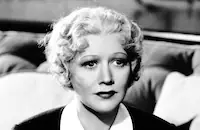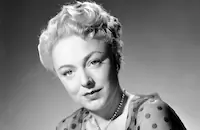The Crystal Ball
Brief Synopsis
Cast & Crew
Elliott Nugent
Ray Milland
Paulette Goddard
Gladys George
Virginia Field
Cecil Kellaway
Film Details
Technical Specs

Synopsis
After her emerald ring disappears one day, wealthy New York City widow Jo Ainsley is advised by her maid to seek the help of Madame Zenobia, a medium, to find it. Unknown to Jo, her maid deliberately hid the jewel and is working with Zenobia, who tells Jo that her missing ring can be found in the drainpipe of her sink. Back at home, Jo is happy to find the emerald ring exactly where Zenobia said it would be. Later, Zenobia meets Texas beauty contestant Toni Gerard, and gets her a job as a shill at a shooting gallery run by Pop Tibbets. On her first day on the job, Toni falls in love with one of the shooting gallery customers, Brad Cavanaugh, who is Jo's attorney. After Zenobia injures herself in a fall, she drafts Toni to impersonate her at an upcoming charity ball. Before the ball, Toni is sent out to interview some of the expected guests and extract personal information about them, which she can later use at her fortune-telling booth. Her first interview is with Brad's personal valet, Biff Carter, who tells Toni that his boss has a buckshot scar on his body in the shape of a heart. During the party, Toni looks into her crystal ball and advises Brad to purchase a particular parcel of land for Jo. Zenobia, who scripted Brad's fortune, knows that the government is considering buying the land for a defense plant, and hopes to earn a profit by selling it to Jo. The next day, Toni, as herself, goes on a date with Brad, and they fall in love. Brad's good fortune runs out, however, when a government investigator accuses him of buying the land with the intent of fleecing the government. Hoping to clear his name, Brad seeks out his fortune-telling advisor, taking Jo and Toni along with him. Toni later asks Zenobia to confess her guilt, but Zenobia, fearing trouble, locks Toni in a closet and flees. Jo finds Toni and tells her that she knows that she was working with Zenobia. Toni then threatens to tell the police about Zenobia's scheme unless the seer clears Brad's name and leaves town. With the help of Biff's intervention, however, Brad and Toni are reunited, and they embrace and kiss.

Director

Elliott Nugent
Cast

Ray Milland

Paulette Goddard

Gladys George

Virginia Field

Cecil Kellaway

William Bendix
Mary Field
Frank Conlan

Ernest Truex
Mabel Paige
Regina Wallace
Peter Jamerson

Fay Helm

Donald Douglas

Nestor Paiva

Sig Arno
Jacques Lory
Paul Bryar

Hillary Brooke
Ken Lundy
Tom Dugan

Iris Adrian
Babe London
June Evans
Billy Dawson
Reginald Sheffield

Charles Irwin
May Beatty
John Harmon
Eric Alden
Don Gallaher

Maude Eburne
Maxine Ardell

Yvonne Decarlo
Christopher King
Alice Kirby
Marcella Phillips
Lorraine Miller
Lynda Grey
Donivee Lee
Marjorie Deanne
Crew
Adrian
Roland Anderson
Richard Blumenthal
B. G. Desylva
Hans Dreier
Farciot Edouart
Mel Epstein
Doane Harrison
Edith Head
Don Johnson
Gene Merritt
George Sawley
Leo Tover
Virginia Van Upp
Steven Vas
Wally Westmore
Victor Young

Film Details
Technical Specs

Articles
The Crystal Ball
That's about the extent of it; the film did nothing to either help or damage Milland's career much, although even the tepid New York Times review noted engaging performances by the leads and by William Bendix, injecting "a bright ray here and there as Mr. Milland's tough-guy valet." Actually, the cast is enlivened by several expert supporting players, not least Gladys George as Madame Zenobia. A promising young actress from the stage, George began her career in silents, but an accident that left her badly burned curtailed her leading lady career and she returned to stock and later Broadway. In the 1930s, she reemerged as more of a character actress, although she received acclaim for starring roles in Valiant Is the Word for Carrie (1936) and the enduring soap opera about wayward mother love, Madame X (1937). She's probably best remembered today, however, for her character parts as DuBarry in Marie Antoinette (1938), the floozy who cradles a dying Cagney in her arms in The Roaring Twenties (1939), and as Miles Archer's widow in The Maltese Falcon (1941). She had one more very notable role in The Best Years of Our Lives (1946) before her career wound down. She died in 1954 at 54 years old.
During production, this film's title was changed from The Crystal Ball to Redheads Are Dangerous, and back again to The Crystal Ball. A pre-production Hollywood Reporter news item noted that Ginger Rogers was originally considered for the lead role, while a modern source noted that Charles Boyer was intended as her co-star. According to another Hollywood Reporter blurb, the picture was originally to close with a train sequence, but the script was rewritten to reflect transportation restrictions imposed during the war.
Near the start of The Crystal Ball, Goddard whistles the tune "(I've Got Spurs That) Jingle, Jangle, Jingle," a hit introduced in her previous movie The Forest Rangers (1942).
Yvonne De Carlo plays a small part as a secretary. It would be a few more years before she emerged from her string of uncredited bit parts with the lead in the period piece Salome Where She Danced (1945). De Carlo would play a number of noteworthy femme fatales in noir thrillers and Westerns over the years, and achieve television fame as Lily in the 1960s comedy series The Munsters.
The Crystal Ball was Goddard's third foray into the realm of supernatural comedy after two movies with Bob Hope, The Cat and the Canary (1939) and The Ghost Breakers (1940). She and Milland co-starred twice before in The Lady Has Plans (1942) and Reap the Wild Wind (1942) and would pair again for the period piece Kitty (1945).
Zenobia has been a popular name for exotic female characters, not just in film but in the literature of Nathaniel Hawthorne, P.G. Wodehouse, Robert Heinlein, Edward Gorey, and Edith Wharton. On screen, she has turned up as the title character of a 70s porn movie and in the person of Anita Ekberg, playing a version of the real-life Zenobia, Queen of Palmyra, who led a revolt against the Roman Empire and established her own sizeable Middle East realm for a time.
Director: Elliott Nugent
Producer: Buddy DeSylva (uncredited), Richard Blumenthal (associate producer)
Screenplay: Virginia Van Upp, story by Steven Vas
Cinematography: Leo Tover
Editing: Doane Harrison
Art Direction: Roland Anderson, Hans Dreier
Original Music: Victor Young
Cast: Ray Milland (Brad Cavanaugh), Paulette Goddard (Toni Gerard), Gladys George (Madame Zenobia), Virginia Field (Jo Ainsley), Cecil Kellaway (Pop Tibbets), William Bendix (Biff Carter).
BW-81m.
by Rob Nixon

The Crystal Ball
Quotes
Trivia
Near the start of the film, Paulette Goddard whistles the tune "I've Got Spurs That Jingle, Jangle, Jingle" -- a hit introduced in her movie The Forest Rangers.
Notes
During production, this film's title was changed from The Crystal Ball to Redheads Are Dangerous, and back again to The Crystal Ball. A pre-production Hollywood Reporter news item noted that Ginger Rogers was originally considered for the lead role, while a modern source noted that Charles Boyer was intended as her co-star. The film marked Helen Walker's feature film debut. According to a Hollywood Reporter news item, the picture was originally to close with a train sequence, but the script was rewritten as all forms of transportation were restricted due to the war. The picture was among a package of films that were produced by Paramount Pictures, Inc. and purchased by United Artists in 1942 for release under the Cinema Guild label.














